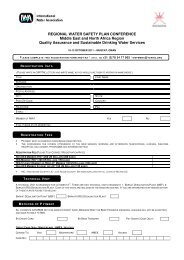Water safety in buildings - libdoc.who.int - World Health Organization
Water safety in buildings - libdoc.who.int - World Health Organization
Water safety in buildings - libdoc.who.int - World Health Organization
You also want an ePaper? Increase the reach of your titles
YUMPU automatically turns print PDFs into web optimized ePapers that Google loves.
<strong>Water</strong> use <strong>in</strong> educational facilities and associated build<strong>in</strong>gs (residential, sport<br />
clubrooms, etc.) can be <strong>in</strong>termittent, with extended periods of stagnation possible,<br />
particularly dur<strong>in</strong>g holidays.<br />
• Hotels. Hotels can <strong>in</strong>clude recreational facilities such as swimm<strong>in</strong>g pools and hottub<br />
pools, and, <strong>in</strong> some cases, rooms can be provided with s<strong>in</strong>gle-use hot-tub baths,<br />
which can be a source of environmental pathogens. Occupancy of hotels and other<br />
accommodation facilities can vary markedly depend<strong>in</strong>g on seasons; build<strong>in</strong>gs, parts<br />
of build<strong>in</strong>gs or floors may be closed dur<strong>in</strong>g “off seasons”. Associated water-us<strong>in</strong>g<br />
devices such as cool<strong>in</strong>g towers and evaporative condensers may also be shut down for<br />
extended periods.<br />
• Conference centres. Where accommodation is provided, these centres can <strong>in</strong>clude<br />
similar features to hotels.<br />
• Apartment blocks (low rise and high rise). Ma<strong>in</strong>tenance and management can<br />
be complicated by <strong>in</strong>dividual ownership or leas<strong>in</strong>g of apartments. Risks <strong>in</strong> shared<br />
hot- and cold-water systems can be <strong>in</strong>creased where <strong>in</strong>dividual apartments are used<br />
<strong>in</strong>frequently or rema<strong>in</strong> empty for extended periods, and through connection of PoU<br />
treatment (e.g. carbon filters) and water-us<strong>in</strong>g devices such as wash<strong>in</strong>g mach<strong>in</strong>es and<br />
dishwashers, and by other modifications undertaken by tenants and apartment owners.<br />
• Office blocks. Like apartment blocks, ma<strong>in</strong>tenance and management can be<br />
complicated by multiple ownership or tenancies.<br />
• Public build<strong>in</strong>gs (e.g. museums, art galleries, theatres and c<strong>in</strong>ema complexes).<br />
A common concern with these build<strong>in</strong>gs is ma<strong>in</strong>ta<strong>in</strong><strong>in</strong>g hygiene and ensur<strong>in</strong>g that<br />
dr<strong>in</strong>k<strong>in</strong>g-water outlets are kept clean.<br />
• Shopp<strong>in</strong>g centres can <strong>in</strong>clude decorative founta<strong>in</strong>s, garden shops and fresh fruit and<br />
vegetable markets that use mist<strong>in</strong>g mach<strong>in</strong>es to keep produce fresh. These spray and<br />
mist devices produce aerosols that can dissem<strong>in</strong>ate organisms such as Legionella<br />
and Mycobacterium spp. if present. Centres can also <strong>in</strong>clude speciality shops such as<br />
hairdress<strong>in</strong>g salons.<br />
• Factories, manufactur<strong>in</strong>g <strong>in</strong>dustries and production centres. These build<strong>in</strong>gs can<br />
<strong>in</strong>clude storages of liquid chemicals and distribution systems that circulate water used<br />
for cool<strong>in</strong>g or liquid coolants. Industrial build<strong>in</strong>gs can <strong>in</strong>clude devices for worker<br />
<strong>safety</strong>, such as eye-wash stations and <strong>safety</strong> showers.<br />
• Transport term<strong>in</strong>als. Transferr<strong>in</strong>g water at term<strong>in</strong>als to aeroplanes, ships, tra<strong>in</strong>s or<br />
buses needs to be managed to ensure that water <strong>safety</strong> is ma<strong>in</strong>ta<strong>in</strong>ed. Specific guidance<br />
for aeroplanes and ships is provided <strong>in</strong> the WHO Guide to hygiene and sanitation <strong>in</strong><br />
aviation (WHO, 2009) and the WHO Guide to ship sanitation (WHO, 2010). The<br />
hygiene and <strong>safety</strong> pr<strong>in</strong>ciples described <strong>in</strong> these guides should also be applied for<br />
tra<strong>in</strong>s and buses.<br />
2.5.2 Hospitals<br />
Hospitals can be very large build<strong>in</strong>gs or complexes with extensive water systems. Due<br />
to the vulnerability of some patients, hospitals are more likely to provide additional<br />
treatment at the po<strong>in</strong>t of entry of external piped supplies. Common forms of treatment<br />
<strong>in</strong>clude filtration, dis<strong>in</strong>fection, softeners and deionizers. Treatment is also likely where<br />
12 <strong>Water</strong> <strong>safety</strong> <strong>in</strong> build<strong>in</strong>gs


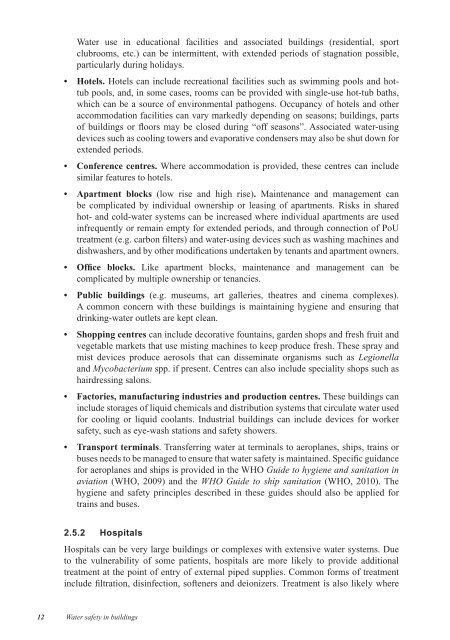
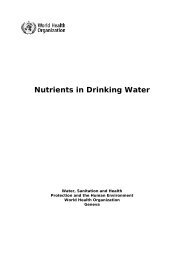
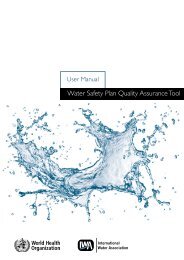

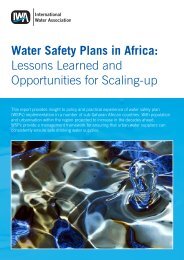

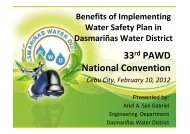
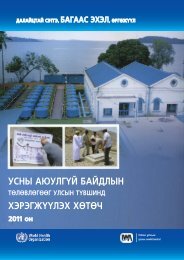

![Pdf [5.32 Mb] - Water Safety Portal](https://img.yumpu.com/32098467/1/190x245/pdf-532-mb-water-safety-portal.jpg?quality=85)
